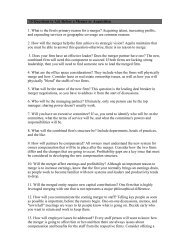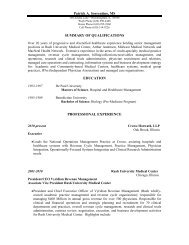Cost Segregation Study - CPAReport
Cost Segregation Study - CPAReport
Cost Segregation Study - CPAReport
You also want an ePaper? Increase the reach of your titles
YUMPU automatically turns print PDFs into web optimized ePapers that Google loves.
<strong>Cost</strong> <strong>Segregation</strong><br />
A Value-Added Service<br />
for Your Clients<br />
Presented by:<br />
Alan J. Smith— Ernst & Morris Consulting Group, Inc.<br />
To:<br />
CPA Leadership Institute
Top Niche Services<br />
(A Percentage of 78 Top Firms Reporting an Increase in that Type of Business)<br />
Attest Services 86%<br />
Business Valuations 82%<br />
Litigation Support 78%<br />
Forensics / Fraud 77%<br />
Estate / Trust Tax Planning 74%<br />
International Tax 68%<br />
Mergers & Acquisitions 68%<br />
Sarbanes - Oxley Compliance 67%<br />
Industry Specializations 64%<br />
Wealth Management 62%<br />
Nonprofit Organizations 55%<br />
<strong>Cost</strong> <strong>Segregation</strong> 54%<br />
State & Local Taxes 54%<br />
Employee Benefits 49%<br />
Retirement Plans 49%<br />
Personal Financial Planning 46%<br />
Technology Consulting 46%<br />
Investment Advice / Services 45%<br />
Strategic / Business Plans 45%<br />
Small Business Management 35%<br />
Bankruptcy / Insolvency 33%<br />
*Adapted from “Accounting Today – Inside<br />
the Top 100 (©2007) (pg 8)”<br />
0% 10% 20% 30% 40% 50% 60% 70% 80% 90% 100%<br />
<strong>Cost</strong> <strong>Segregation</strong>: a cash flow solution
Relevant History<br />
1981<br />
1984<br />
1986<br />
1993<br />
2002/<br />
2008<br />
2004/<br />
2008<br />
Established Recovery Periods for Most Business Property<br />
At 5 to 15 Years.<br />
Extended Recovery Periods to 19 Years (Tax Act).<br />
Extended Recovery Periods from 19 Years to 31.5 Years<br />
Straight-Line. (MACRS)<br />
Extended Recovery Period from 31.5 Years to 39 Years.<br />
Temporary 30% / 50% Bonus Depreciation<br />
(CO dated by 12/31/09).<br />
Qualified Leasehold & Certain Retail Improvements from<br />
39 Years to 15 Years Straight-Line (effective 10/22/04 to<br />
12/31/2009).<br />
Tax savings by the square foot
Property<br />
Class<br />
Description<br />
Current Status<br />
Method<br />
39-Year Nonresidential Real Property Straight Line<br />
27.5-Year Residential Rental Property Straight Line<br />
15-Year Land Improvements 150 DB<br />
15-Year<br />
7-Year<br />
5-Year<br />
Qualified Leasehold & Certain Retail<br />
Improvements (effective 10/22/04-1/09)<br />
Office Furniture, Fixtures, Equipment,<br />
Certain Personal Property<br />
Cars, Trucks, Computer Related<br />
Equipment, Certain Personal Property<br />
Straight Line<br />
200 DB<br />
200 DB<br />
Benefits are substantial, immediate, and enduring.
Past Precedent<br />
-ACRS -> MACRS (1986)<br />
-HCA – ITC still relevant<br />
-IRS Revenue Rulings / Court Cases<br />
-Whiteco Factors<br />
<strong>Cost</strong> <strong>Segregation</strong>: a cash flow solution
Industry Directives<br />
Audit Techniques Guide<br />
- Not Official Pronouncement of Law<br />
- Not Official Position of IRS<br />
- Primarily Used for Risk Analysis<br />
- Promotes Consistency, Efficiency<br />
- No Bright Line Test - Necessitates IRS Engineers<br />
<strong>Cost</strong> <strong>Segregation</strong>: a cash flow solution
<strong>Cost</strong> <strong>Segregation</strong> <strong>Study</strong> Types<br />
Engineering Approach:<br />
- Complete Listing of All Project <strong>Cost</strong>s<br />
- On-site Inspection of Assets<br />
- Official Documentation/Plan Review<br />
- Cross-reference Take-off w/ Payment Records<br />
- Proper Allocation of Indirect <strong>Cost</strong>s<br />
- Clear <strong>Segregation</strong> of Property into Asset Classes<br />
“the most methodical and accurate<br />
approach, relying on solid documentation<br />
and minimal estimation.”<br />
(IRS <strong>Cost</strong> <strong>Segregation</strong> ATG Ch. 3)
<strong>Cost</strong> <strong>Segregation</strong> <strong>Study</strong> Types<br />
Engineering <strong>Cost</strong> Estimation Approach:<br />
- Similar to Engineering Approach<br />
- Estimated <strong>Cost</strong>s Used in lieu of Actual <strong>Cost</strong> Data<br />
- Used if <strong>Cost</strong> Records Not Available or for the<br />
Allocation of A Purchase Price<br />
- <strong>Cost</strong> Estimations Must Be Referenced from<br />
Reliable Sources (e.g. Means or Marshall, etc.)<br />
<strong>Cost</strong> <strong>Segregation</strong>: a cash flow solution
<strong>Cost</strong> <strong>Segregation</strong> <strong>Study</strong> Types<br />
Survey / Letter Approach:<br />
- Also an Estimation<br />
- <strong>Cost</strong>s Obtained from Contractors or Vendors<br />
- Used in Engineering or Estimation Approach<br />
<strong>Cost</strong> <strong>Segregation</strong>: a cash flow solution
<strong>Cost</strong> <strong>Segregation</strong> <strong>Study</strong> Types<br />
Residual Estimation Approach:<br />
- Only Short-life Asset <strong>Cost</strong>s are Determined<br />
- „Residual‟ <strong>Cost</strong> Assigned to 39 Year Property<br />
“Although this method is simpler and less<br />
time consuming than the engineering approaches,<br />
it can also be less accurate”<br />
(IRS <strong>Cost</strong> <strong>Segregation</strong> ATG, Ch. 3)<br />
<strong>Cost</strong> <strong>Segregation</strong>: a cash flow solution
<strong>Cost</strong> <strong>Segregation</strong> <strong>Study</strong> Types<br />
Sampling or Modeling Approach:<br />
- Created Model or Template for Prototypes<br />
- <strong>Study</strong> Performed on „Representative Sample‟<br />
Generalized to Property Population<br />
“to analyze multiple facilities that are nearly<br />
identical in construction, appearance, and use”<br />
(IRS Audit Techniques Guide, Ch.3)
<strong>Cost</strong> <strong>Segregation</strong> <strong>Study</strong> Types<br />
Desktop or ‘Back of Napkin’ Approach:<br />
- Little or No Documentation<br />
- Usually Based on Estimated Percentages<br />
- Does Not Withstand IRS Scrutiny<br />
<strong>Cost</strong> <strong>Segregation</strong>: a cash flow solution
Summary of IRS Report Guidelines<br />
- Report Methodology<br />
- Third-party, Engineering-based Studies<br />
- On-site Verification of Assets<br />
- Reliable, Documented <strong>Cost</strong> Sources<br />
- Cross-referenced Documentation<br />
“an underlying assumption is that the<br />
study is performed by "qualified" individuals or<br />
firms, such as those employing …personnel<br />
competent in design, construction, auditing, and<br />
estimating procedures relating to building<br />
construction”<br />
(IRS <strong>Cost</strong> <strong>Segregation</strong> ATG, Ch. 3)
<strong>Cost</strong> <strong>Segregation</strong> Opportunities<br />
• New construction<br />
• Purchase of existing property<br />
• Renovations or expansions<br />
• Leasehold improvements<br />
• Existing property placed in service<br />
after 1986 (“look-backs”)<br />
• Real property stepped-up through estate<br />
• Treatment of 1031 Exchange Funds<br />
Reduce Taxes, Improve Cash Flow
<strong>Cost</strong> <strong>Segregation</strong> Qualifications<br />
• Legal Entity Structure/Basis<br />
- Pass Through Entities<br />
◦ Partnerships, LPs, LLPs<br />
◦ LLCs<br />
◦ S Corps<br />
◦ Certain Trusts<br />
- C-Corps<br />
- REITs<br />
• Motivation of Taxpayer<br />
- Depreciation Recapture – Hold Property or Sell Eventually?<br />
• Net Passive Loss<br />
• Alternative Minimum Tax (“AMT”)<br />
Tax savings by the square foot
Typical Percentages of Accelerated Property<br />
Property Types<br />
Typical % Eligible<br />
Heavy Manufacturing/Processing 30-60%<br />
Research & Development 30-60%<br />
Car Dealerships 25-50%<br />
Light Manufacturing 20-40%<br />
MOB’S / MAB’S 20-40%<br />
Golf Courses 20-40%<br />
Offices 20-40%<br />
Restaurants (Single or Multiple) 20-40%<br />
Apartments 20-35%<br />
<strong>Cost</strong> <strong>Segregation</strong>: a cash flow solution
Typical Percentages of Accelerated Property<br />
Property Types<br />
Typical % Eligible<br />
Retail (Dept/Specialty Stores) 20-30%<br />
Theaters 20-30%<br />
Grocery Stores 20-30%<br />
Hotels/Motels 20-30%<br />
Senior Living/Assisted Living 15-25%<br />
Strip or Regional Malls 5-30%<br />
Tenant Improvements 5-50%<br />
Warehouses 5-10%<br />
Benefits are substantial, immediate, and enduring.
Data Requirements<br />
New Construction, Leasehold Improvements<br />
and Renovation<br />
1. Tax Depreciation Schedules (“look-back” only)<br />
2. Site Survey (“look-back” only)<br />
3. Capitalized <strong>Cost</strong> Supported By:<br />
-AIA Payment Application (form G702/G703)<br />
-Change Orders (including description & cost)<br />
4. Project Budget Summarizing All Associated <strong>Cost</strong>s<br />
-Indirect <strong>Cost</strong>s Not Included in Pay Application<br />
-<strong>Cost</strong> Paid Directly to Subcontractors Outside General Contract<br />
5. Complete Set of As-Built Construction Drawings is Required<br />
(after proposal approval)<br />
<strong>Cost</strong> <strong>Segregation</strong>: a cash flow solution
Data Requirements<br />
Purchase Price Allocation<br />
1. Closing Statement<br />
2. Recent Appraisal<br />
3. Property Rent Roll as of Acquisition Date<br />
4. Historical Information<br />
-Tax Depreciation Schedules or Fixed Asset<br />
Schedules (look-back only)<br />
-Inventories of Furniture, Fixtures, & Equipment<br />
5. Land Value Allocated<br />
6. Site Survey<br />
7. Any Available Construction Drawings<br />
Benefits are substantial, immediate, and enduring.
NPV Estimate Request Form<br />
Tax savings by the square foot
The Benefit<br />
Each $100,000 in assets reclassified from<br />
a 39-year recovery period to a five-year<br />
recovery period results in approximately<br />
$22,000 in net-present-value savings,<br />
assuming an 8% discount rate and a 40%<br />
marginal tax rate.<br />
Journal of Accountancy, Copyright 2005 by the AICPA<br />
Reduce Taxes, Improve Cash Flow
The Benefit Applied<br />
$10 million retail shopping center, placed into service 10 years ago:<br />
Original Depreciation Method: 39-year Straight Line<br />
Reclassified Amount with <strong>Cost</strong> <strong>Segregation</strong> <strong>Study</strong>:<br />
• 5-year Property- $1 million<br />
• 15-year Property- $1.5 million<br />
Adjustment Calculation and Resulting Tax Benefit:<br />
Depreciation Reported Previously $2,564,100<br />
<strong>Cost</strong> <strong>Segregation</strong> <strong>Study</strong> Depreciation $3,923,070<br />
Section 481(a) Adjustment ($1,358,970)<br />
Tax Rate 40%<br />
Tax Benefit in Year of <strong>Study</strong> $543,588<br />
The Bottom Line – by performing an engineering-based<br />
cost seg study, the building owner was able to increase the<br />
amount of depreciation expense, thus reducing the current<br />
year taxable income, resulting in an increase in cash flow<br />
of $544k.<br />
Tax savings by the square foot
<strong>Cost</strong> <strong>Segregation</strong> <strong>Study</strong> - Tax Benefit Summary<br />
1996 Purchase Price Allocation - Look back (<strong>Study</strong> Done in 2001)<br />
Apartment Building & Improvements<br />
MACRS Classifications<br />
Property 27.5 YEAR % 15 YEAR % 5 YEAR %<br />
Apartments<br />
Rochester, NY<br />
$12,950,000 70% $2,590,000 14% $2,960,000 16%<br />
336 Units<br />
Total<br />
1 st YEAR<br />
NPV NPV* FEE ROI**<br />
$18,500,000 $1,185,000 $748,000 $15,000 50 to 1<br />
* Net Present Value assumes a 27.5 year holding period, an 8% discount<br />
rate and a 40% tax rate.<br />
**Computed Using the After Tax Fee<br />
<strong>Cost</strong> <strong>Segregation</strong>: a cash flow solution
<strong>Cost</strong> <strong>Segregation</strong> <strong>Study</strong> - Tax Benefit Summary<br />
New Construction<br />
Free-Standing Restaurant<br />
MACRS Classifications<br />
Property 39 YEAR % 15 YEAR % 7/5 YEAR %<br />
Restaurant<br />
Portland, OR<br />
8,220 SF<br />
$836,901 57% $284,016 19% $345,991 24%<br />
Total NPV* FEE ROI**<br />
1,466,908 $109,495 $7,000 16 TO 1<br />
* Net Present Value assumes a 39 year holding period, an 8% discount<br />
rate and a 40% tax rate.<br />
**Computed Using the After Tax Fee<br />
Benefits are substantial, immediate, and enduring.
<strong>Cost</strong> <strong>Segregation</strong> <strong>Study</strong> - Tax Benefit Summary<br />
New Construction<br />
Hotel Building and Land Improvements<br />
MACRS Classifications<br />
Property 39 YEAR % 15 YEAR % 7/5 YEAR %<br />
Hotel<br />
Cocoa Beach, FL<br />
150 Units<br />
$5,131,014 75% $860,795 13% $836,952 12%<br />
Total NPV* FEE ROI**<br />
$6,828,761 $285,517 $10,000 29 TO 1<br />
*Net Present Value assumes a 39 year holding period, an 8% discount<br />
rate and a 40% tax rate.<br />
**Computed Using the After Tax Fee<br />
Reduce Taxes, Improve Cash Flow
<strong>Cost</strong> <strong>Segregation</strong> <strong>Study</strong> - Tax Benefit Summary<br />
New Construction & Renovation<br />
Research & Development Facility with Land Improvements<br />
MACRS Classifications<br />
Property 39 YEAR % 15 YEAR % 7/5 YEAR %<br />
R & D<br />
Huntersville, NC<br />
32,476 SF<br />
$4,895,447 69% $698,392 10% $1,505,850 21%<br />
Total NPV* FEE ROI**<br />
$7,099,689 $424,951 $19,000 36 TO 1<br />
*Net Present Value assumes a 39 year holding period, an 8% discount<br />
rate and a 40% tax rate.<br />
**Computed Using After Tax Fee
<strong>Cost</strong> <strong>Segregation</strong> <strong>Study</strong> - Tax Benefit Summary<br />
Purchase Price Allocation<br />
Manufacturing Facility with Land Improvements<br />
MACRS Classifications<br />
Property 39 YEAR % 15 YEAR % 7/5 YEAR %<br />
Manufacturing<br />
Facility<br />
$4,895,447 59% $896,282 25% $567,353 16%<br />
Mechanicsville,<br />
Virginia<br />
200,000 SF<br />
Total<br />
$3,529,475<br />
NPV*<br />
$220,502<br />
FEE<br />
$6,300<br />
ROI**<br />
58 TO 1<br />
*Net Present Value assumes a 39 year holding period, an 8% discount<br />
rate and a 40% tax rate.<br />
**Computed Using After Tax Fee
Quality <strong>Study</strong> Procedure<br />
1. Estimate<br />
2. Proposal Letter<br />
3. Document Collection<br />
4. <strong>Cost</strong> Analysis<br />
5. Engineering Analysis<br />
6. Take Off<br />
7. Site Visit<br />
8. Reconciliation of <strong>Cost</strong>s and Take Off<br />
9. Work Papers<br />
10. Final Report<br />
Benefits are substantial, immediate, and enduring.
Audit Performance<br />
1. What to Expect in an Audit<br />
2. Audit Procedure<br />
- IDR<br />
- Audit Intent<br />
- Review of CS <strong>Study</strong><br />
- Review of Tax Depreciation Schedule<br />
- Interview with Preparer<br />
- Site Visit<br />
- Resolve Issues, Determine any Reconciliation<br />
3. What to Expect from your CS Firm in an Audit<br />
Benefits are substantial, immediate, and enduring.
Change In Accounting Method<br />
• Generally it's:<br />
“a change in the overall plan of accounting for<br />
gross income or deductions, or a change in the<br />
treatment of any material item. A material item<br />
is any item that involves the proper time for the<br />
inclusion of the item in income or the taking of<br />
the item as a deduction.” (Reg §1.446-<br />
1(e)(2)(ii)(a))<br />
Benefits are substantial, immediate, and enduring.
Change In Accounting Method<br />
• According to Reg. 1.446-1 a change in<br />
depreciation method, period of recovery or<br />
convention is a change in accounting method.<br />
• The regulation also recognizes that a 481a<br />
adjustment may result.<br />
• See the Reg. 1.446-1, Example 9, for an<br />
illustration of how the reg applies to a cost seg<br />
study.<br />
Benefits are substantial, immediate, and enduring.
Change In Accounting Method<br />
Revenue Procedure 2002-9 provides basic rules for change<br />
in accounting method with respect to depreciation<br />
- Took effect January 7, 2002<br />
Main Provisions:<br />
- Provides for automatic consent unless:<br />
• Taxpayer under exam<br />
• Appeals<br />
• Federal Court<br />
- To get automatic consent :<br />
• File complete application in duplicate:<br />
• One copy with timely (including extensions) tax return<br />
• Signed copy to IRS National Office filed no later than due<br />
date of return & no earlier than beginning of tax year of change<br />
- Appendix section 2 governs<br />
depreciation<br />
Benefits are substantial, immediate, and enduring.
Change In Accounting Method<br />
Revenue Procedure 2002-19<br />
- Took effect March 14, 2002<br />
- Clarifies the treatment of a 481a adjustment:<br />
• Positive adjustment is recognized over 4 years<br />
• Negative adjustment is recognized entirely in<br />
year of change<br />
Benefits are substantial, immediate, and enduring.
Change In Accounting Method<br />
Completing Form 3115<br />
Form 3115<br />
- Calculate 481a adjustment<br />
- Fill in applicable sections of the form - see example<br />
- Some attachments will be required to support:<br />
• Part II, question 12 a - d & question 13<br />
• Schedule E, question 4<br />
• Schedule E, question 5<br />
• Schedule E, question 7 a - e<br />
Benefits are substantial, immediate, and enduring.
Change In Accounting Method<br />
Completing Form 3115 (Continued)<br />
• Required statement:<br />
“Each item of property that is the subject of the application<br />
filed under section 2.01 of the appendix of Rev. Proc.<br />
2002-9 as revised by Rev. Proc. 2004-11, for the year of<br />
change beginning January 1, 20___, and that is reclassified<br />
from nonresidential (or residential real property) to an asset<br />
class of Rev. Proc. 87-56, 1987-2 C.B. 674 (or Rev Proc<br />
83-35, 1983-1 CB 745) that does not explicitly include<br />
section 1250 property, is section 1245 property for<br />
depreciation purposes.”<br />
• 481a adjustment - be sure to include regular<br />
tax as well as AMT<br />
Benefits are substantial, immediate, and enduring.
Change In Accounting Method<br />
Completing Form 3115 (Continued)<br />
- Attach one copy of form 3115 to the tax return<br />
- File one copy of form 3115 (signed) with the IRS<br />
National Office<br />
- Refer to the form 3115 instructions for<br />
filing address, currently:<br />
Internal Revenue Service<br />
Attention: CC:PA:LPD:DRU<br />
Automatic Rulings Branch<br />
PO Box 7604<br />
Ben Franklin Station<br />
Washington, DC 20044<br />
Benefits are substantial, immediate, and enduring.
1031 Exchanges & <strong>Cost</strong> <strong>Segregation</strong><br />
1031 allows deferral of gain in an exchange of<br />
like kind property<br />
<strong>Cost</strong> segregation allows taxpayers to accelerate<br />
depreciation deductions on property and thus defer tax<br />
<strong>Cost</strong> segregation studies can work in conjunction<br />
with 1031 exchanges<br />
Exchanged basis of replacement MACRS property is<br />
depreciated using the relinquished property's:<br />
•Remaining recovery period<br />
•Depreciation method<br />
•Convention<br />
Benefits are substantial, immediate, and enduring.
1031 Exchanges & <strong>Cost</strong> <strong>Segregation</strong><br />
If there is excess basis on an exchange, i.e., new<br />
building FMV exceeds FMV of old, the excess basis<br />
can be depreciated under an accelerated method<br />
through a cost segregation study.<br />
Recapture could result:<br />
- <strong>Cost</strong> segregation studies result in reclassification of 1250<br />
to 1245 property<br />
- If replacement 1245 property does not equal<br />
relinquished 1245 property - recapture occurs<br />
at ordinary rates<br />
Benefits are substantial, immediate, and enduring.
1031 Exchanges & <strong>Cost</strong> <strong>Segregation</strong><br />
- Recapture can also occur on 1250 property,<br />
but only the excess of additional depreciation<br />
over straight line depreciation is recaptured.<br />
• Usually land improvements generate additional<br />
depreciation subject to recapture because they are<br />
depreciated using 150%DB vs. SL<br />
Benefits are substantial, immediate, and enduring.
Other Considerations<br />
-Section 754 Step Up / Inherited Property<br />
-Passive Loss Issues<br />
-Net Operating Losses<br />
-AMT Status<br />
Benefits are substantial, immediate, and enduring.
Energy Policy Act of 2005 (EPAct)<br />
• Incentivized areas:<br />
– Lighting<br />
– HVAC<br />
– Building envelope<br />
• Available for New Construction and Existing Buildings<br />
• Also available for:<br />
– Tenant owned lease-hold improvements<br />
– Rental Apartment Buildings 4 stories or above<br />
– Primary Designers of Government Buildings
CPA firms can Expand Service Offerings<br />
Commercial Building<br />
Owners<br />
• Retailers<br />
• Industrial Buildings<br />
• Warehouses<br />
• Office Buildings<br />
Primary Designers of<br />
Government Buildings<br />
• Architects<br />
• Engineers<br />
• Lighting Designers<br />
• Design & Build<br />
Firms
Credit/Grants<br />
Specified Energy Property Credit Termination Date Applicable Percentage of<br />
Eligible <strong>Cost</strong> Basis<br />
Geothermal Heat Pumps Jan 1, 2017 10%<br />
Fuel Cells Jan 1, 2017 30%**<br />
Microturbines Jan 1, 2017 10%***<br />
Combined Heat & Power Jan 1, 2017 10%<br />
Large Wind Jan 1, 2013 30%<br />
Closed-Loop Biomass Facility Jan 1, 2014 30%<br />
Open-loop Biomass Facility Jan 1, 2014 30%<br />
Geothermal under IRC sec. 45 Jan 1, 2014 30%<br />
Landfill Gas Facility Jan 1, 2014 30%<br />
Trash Facility Jan 1, 2014 30%<br />
Qualified Hydropower Facility Jan 1, 2014 30%<br />
Marine & Hydrokinetic Jan 1, 2014 30%<br />
Solar Jan 1, 2017 30%<br />
Geothermal under IRC sec. 48 Jan 1, 2017 10%*<br />
Small Wind Jan 1, 2017 30%<br />
*Geothermal Property that meets the definitions of qualified property in both § 45 and § 48 is allowed either the 30% credit<br />
or the 10% credit but not both.<br />
** For fuel cell property the maximum amount of the payment may not exceed an amount equal to $1,500 for each 0.5<br />
kilowatt of capacity.<br />
*** For microturbine property the maximum amount of the payment may not exceed an amount equal to $200 for each<br />
kilowatt of capacity.
Additional Benefits of Credits/Grants<br />
• 5 year accelerated depreciation<br />
• bonus depreciation<br />
• additional depreciation for 50% of the<br />
credit/grant amount
Grant in Lieu of Tax Credit<br />
• Great for companies who don’t pay taxes<br />
• Forms have been released<br />
• Applications now being Accepted<br />
– For projects placed in service after:<br />
• 1/1/2009<br />
– or projects started before:<br />
• 12/31/2010<br />
• Applications accepted through 10/1/2011<br />
• Marketing the Grant<br />
– Get the word out<br />
– Include Grant in Proposals
Geothermal Heat Pumps<br />
• Tremendous Opportunity<br />
– Benefits<br />
• Energy Savings<br />
• 10% Grant/Tax Credit<br />
• 5 Year Depreciation<br />
• Bonus Depreciation<br />
• Depreciation of 50% of Grant/Tax Credit amount<br />
• Building will likely qualify for $1.80/sq.ft. EPAct Tax<br />
Deduction
Questions and Answers<br />
For Further Information Contact<br />
Alan Smith – Director – <strong>Cost</strong> <strong>Segregation</strong><br />
Ernst & Morris Consulting Group, Inc.<br />
2190 Dallas Highway<br />
Marietta, Georgia 30064<br />
Telephone: (770) 427-9677 x13 or<br />
1-800-COST-SEG<br />
Fax: (770) 427-4004<br />
E-Mail: asmith@costseg.com<br />
www.costseg.com






